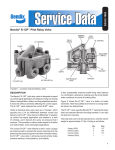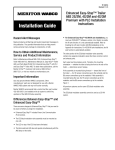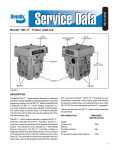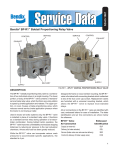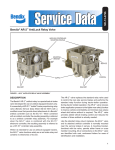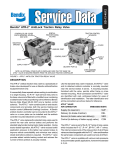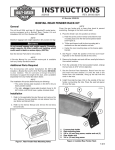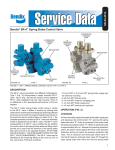Download BENDIX BW1625 User's Manual
Transcript
SD-03-953 ® Bendix® LQ-5™ Bobtail Ratio Valve 1.5" 3/8 P.T. SUPPLY PORT .340” MOUNTING HOLES (2) STAMPED LQ-5 REPLACEMENT PC. NO. 1/8 P.T. CONTROL PORT 3/8 P.T. DELIVERY PORT FIGURE 1 - LQ-5™ BOBTAIL RATIO VALVE DESCRIPTION The LQ-5™ bobtail ratio valve is used on the front (steering) axle of tractor air brake systems to reduce brake application pressure during normal tractor-trailer operation. It is designed for tractor systems only and replaces the existing front axle limiting valve. It is not to be used on straight trucks or towing trucks. Also, a quick release valve must be installed between the LQ-5™ valve delivery and the brake chambers. Although it is not mandatory, the LQ-5™ valve is used in conjunction with the BP-R1™ bobtail brake proportioning relay valve, only when a customer specifies a front axle ratio valve. The BP-R1™ valve and LQ-5™ valve combine to reduce stopping distance and improve tractor control in bobtail mode. (For more information on the BP-R1™ valve, see SD-03-1067.) IMPORTANT: Do not replace the BP-1™ front brake proportioning valve with the LQ-5™ valve. The LQ-5™ valve will not function properly in the BP-1™ valve system. GENERAL Caution: The LQ-5™ valve can replace the LQ-4™ ratio valve on tractors. The LQ-5™ valve control port must be connected to the trailer supply line. When the tractor is disconnected from the trailer, bobtail tractor braking performance is improved because full brake valve pressure will be applied to the steering axle brakes. OPERATION After an initial delivery, the LQ-5™ valve limits front axle brake pressure during normal tractor-trailer operation. The LQ-5™ valve has two spring-loaded pistons: a blend back piston and a proportioning piston. The “stepped” proportioning piston determines actual air pressure reduction and the blend back piston allows the valve’s delivery pressure to “blend back” and reach a 1:1 ratio during high pressure brake applications. 1 BRAKE CHAMBER PP-7™ TRAILER SUPPLY VALVE BRAKE VALVE SUPPLY QUICK RELEASE VALVE LQ-5™ VALVE LP-3™ LOW PRESSURE INDICATOR GAUGE DELIVERY BRAKE CHAMBER FRONT AXLE SERVICE RESERVOIR FIGURE 2 - LQ-5™ BOBTAIL RATIO VALVE INSTALLATION The LQ-5™ valve also allows full service pressure to pass through it when the trailer supply valve (red octagonal button) is pulled out—when the tractor is running in bobtail mode. Note: LQ-5™ valve control pressure, which comes from the trailer supply line, will vary. As a result, the LQ-5™ valve delivery and blend back ranges will also vary, because the blend back piston works against control pressure. Figure 3 shows the LQ-5™ valve delivery range at two control pressures: 90 psi and 120 psi. CONTROL PRESSURE 120 PSI FRONT AXLE BRAKE CHAMBER PRESSURE CONTROL PRESSURE 90 PSI NO CONTROL PRESSURE INITIAL DELIVERY PRESSURE 0 Brake Application—LQ-5™ Valve Limiting During tractor-trailer operation, the trailer supply valve (red octagonal button) is depressed and delivers air pressure simultaneously to the trailer and to the LQ-5™ valve control port. Air pressure enters the LQ-5™ valve control port and displaces the blend back piston, against the resistance of its spring, until the piston contacts the cover. Control pressure holds the blend back piston against the cover and the “initial delivery” spring forces the proportioning piston to its seat in the body, which opens the inlet. The “initial delivery” pressure is designed to ensure that the brake linings contact the brake drums before proportioning occurs. The exhaust valve is sealed due to its spring. Brake valve air pressure enters the supply port, moves through the center of the pistons, around the inlet/exhaust valve, and out to the front axle actuators. Air pressure being delivered to the brake actuators is also present beneath the proportioning piston. Because the area on the delivery side of the proportioning piston is larger than that on the supply side, the delivery side needs less air pressure to apply the same force. BRAKE VALVE DELIVERY PRESSURE FIGURE 3 - LQ-5™ BOBTAIL RATIO VALVE PERFORMANCE CURVE 2 TRACTOR-TRAILER MODE Therefore after the initial delivery pressure, the LQ-5™ valve delivers less air pressure to the front axle than it receives from the brake valve. COVER DUAL BRAKE VALVE BLEND BACK SPRING BODY TRAILER SUPPLY VALVE BLEND BACK PISTON INITIAL DELIVERY PISTON PROPORTIONING PISTON FRONT BRAKE CHAMBER INLET/ EXHAUST VALVE FIGURE 4 - LQ-5™ BOBTAIL RATIO VALVE LIMITING: TRACTOR-TRAILER MODE (SHOWN DURING INITIAL DELIVERY) BALANCED BRAKE VALVE APPLICATION - LQ-5™ VALVE HOLDING BRAKE VALVE APPLICATION PRESSURE The forces acting on the proportioning piston are equal when air pressure beneath the piston is approximately one-half of that above. (For example, if a 40 psi brake application is made, approximately 20 psi would be present beneath the proportioning piston.) At this point, the proportioning piston lifts and closes the inlet. The exhaust passage remains sealed. With both the inlet and exhaust valves closed, the LQ-5™ valve is balanced—front axle air pressure is neither increasing nor decreasing. BRAKE VALVE RELEASE Upon brake valve release, air pressure above the blend back piston returns to the brake valve and exhausts. Air pressure from the delivery line lifts the proportioning piston and inlet/ exhaust valve away from the exhaust seat in the body. Air then flows out the open exhaust passage. Air from the actuators exhausts through the quick release valve. (See Figure 2.) If the service brakes are rapidly released, air pressure may lift the inlet/exhaust valve further against the relatively light resistance of the valve spring. Air would then also flow back through the open inlet and out to the brake valve. APPROXIMATELY 1/2 OF BRAKE VALVE APPLICATION PRESSURE FIGURE 5 - LQ-5™ BOBTAIL RATIO VALVE HOLDING: TRACTOR-TRAILER MODE 3 FIGURE 6 - LQ-5™ BOBTAIL RATIO VALVE RELEASING: TRACTOR-TRAILER MODE FIGURE 8 - LQ-5™ BOBTAIL RATIO VALVE MODE When air pressure beneath the proportioning piston depletes to less than approximately 8 psi, the valve spring is able to seat the exhaust valve. The “initial delivery” spring keeps the inlet open and allows air from the LQ-5™ valve delivery to flow through the valve, out the supply and back to the brake valve. BRAKE APPLICATION—LQ-5™ VALVE BLENDING BACK Service brake pressure enters the LQ-5™ valve supply port and combines with the force of the blend back spring to work against control pressure. When service pressure is sufficiently high (see Figure 3), the total downward force begins to overcome the upward force of control pressure on the blend back piston. The blend back piston is forced into contact with the proportioning piston. Both pistons now move as one. Because of the added surface area of the blend back piston, LQ-5™ valve delivery pressure “catches up” as supply pressure increases. When the piston assembly contacts its seat in the body, the LQ-5™ valve delivers full application pressure. There is then a 1:1 ratio between supply and delivery. BOBTAIL MODE BRAKE VALVE APPLICATION, BALANCE, RELEASE When the trailer supply valve is pulled out, air in the LQ-5™ valve control port flows back to the trailer supply valve and exhausts to atmosphere. With no control pressure, the blend back piston is forced by its spring to contact the proportioning piston. The inlet/exhaust valve is held by its spring and seals the exhaust passage. Both pistons, now moving as one, reach their stop in the body. FIGURE 7 - LQ-5™ BOBTAIL RATIO VALVE BLENDING BACK: TRACTOR-TRAILER MODE 4 This is the position for bobtail mode apply, hold and release. The LQ-5™ valve delivers full service application pressure in bobtail mode. Upon brake valve release, delivery air pressure flows back through the LQ-5™ valve, to the brake valve and out to atmosphere. Air from the actuators exhausts through the quick release valve. WARNING! PLEASE READ AND FOLLOW THESE INSTRUCTIONS TO AVOID PERSONAL INJURY OR DEATH: When working on or around a vehicle, the following general precautions should be observed at all times. 1. Park the vehicle on a level surface, apply the parking brakes, and always block the wheels. Always wear safety glasses. 2. Stop the engine and remove ignition key when working under or around the vehicle. When working in the engine compartment, the engine should be shut off and the ignition key should be removed. Where circumstances require that the engine be in operation, EXTREME CAUTION should be used to prevent personal injury resulting from contact with moving, rotating, leaking, heated or electrically charged components. 3. Do not attempt to install, remove, disassemble or assemble a component until you have read and thoroughly understand the recommended procedures. Use only the proper tools and observe all precautions pertaining to use of those tools. 4. If the work is being performed on the vehicle’s air brake system, or any auxiliary pressurized air systems, make certain to drain the air pressure from all reservoirs before beginning ANY work on the vehicle. If the vehicle is equipped with an AD-IS™ air dryer system or a dryer reservoir module, be sure to drain the purge reservoir. 5. Following the vehicle manufacturer’s recommended procedures, deactivate the electrical system in a manner that safely removes all electrical power from the vehicle. 6. Never exceed manufacturer’s recommended pressures. 7. Never connect or disconnect a hose or line containing pressure; it may whip. Never remove a component or plug unless you are certain all system pressure has been depleted. 8. Use only genuine Bendix ® replacement parts, components and kits. Replacement hardware, tubing, hose, fittings, etc. must be of equivalent size, type and strength as original equipment and be designed specifically for such applications and systems. 9. Components with stripped threads or damaged parts should be replaced rather than repaired. Do not attempt repairs requiring machining or welding unless specifically stated and approved by the vehicle and component manufacturer. 10. Prior to returning the vehicle to service, make certain all components and systems are restored to their proper operating condition. PREVENTIVE MAINTENANCE GENERAL Perform the following tests and inspections at the prescribed intervals. If the LQ-5™ valve fails to function as described or if leakage is excessive, repair the valve or replace it with a new or genuine Bendix remanufactured unit, available at any authorized parts outlet. Important: Review the Bendix Warranty Policy before performing any intrusive maintenance procedures. A warranty may be voided if intrusive maintenance is performed during the warranty period. No two vehicles operate under identical conditions, as a result, maintenance intervals may vary. Experience is a valuable guide in determining the best maintenance interval for air brake system components. At a minimum, the valve should be inspected every 6 months or 1500 operating hours, whichever comes first, for proper operation. Should the valve not meet the elements of the operational tests noted in this document, further investigation and service of the valve may be required. OPERATION & LEAKAGE TESTS OPERATION TEST To properly test the LQ-5™ valve, use a pair of test gauges or gauges of known accuracy. 1. With the trailer supply valve pushed in (tractor-trailer mode), install two air gauges in the front axle service system: one between the brake valve and the LQ-5™ valve and one at a front axle actuator. 2 Build system pressure to governor cut-out setting. 3. Make a service brake application with the foot valve and have someone observe the gauges. When the gauge between the foot valve and the LQ-5™ valve reaches 40 psi, the actuator gauge should read approximately 20 psi (±5 psi). 4. Make a full service brake application. Both gauges should read the same pressure. 5. With the trailer supply valve pulled out (bobtail mode), make a 30-40 psi service brake application. Both gauges should read the same pressure. 6. Remove the test gauges. LEAKAGE TEST 1. Build system pressure to governor cut-out. With the trailer supply valve pushed in (tractor-trailer mode), apply a soap solution to the LQ-5™ valve exhaust port. The leakage should not exceed a 1" bubble in less than 3 seconds. 5 2. Make and hold a full brake application and apply a soap solution to the exhaust port and around the cover where it joins the body. The leakage should not exceed a 1" bubble in less than 3 seconds. VALVE REMOVAL 1. Secure the vehicle on a level surface by means other than the brakes. 2. Drain air system completely, making sure all reservoirs are at atmospheric pressure. COVER BLEND BACK SPRING 1 INITIAL DELIVERY SPRING SPRING SEAT 2 3. Identify and mark all air lines and their respective connections on the valve. BLEND BACK PISTON 4. Disconnect all air lines. 5. Remove the valve from the vehicle. VALVE INSTALLATION If the vehicle has a front axle ratio or limiting valve (such as the Bendix® LQ-4™ valve), it can be replaced with an LQ-5™ valve. The LQ-5™ valve control port must be connected to the trailer supply line. Also, a quick release valve must be installed between the LQ-5™ valve delivery and the brake chambers. 6 5 4 3 PROPORTIONING SPRING BODY 1. Install all air line fittings making certain thread sealing material does not enter the valve. 2. Mount the assembled valve on the vehicle with the exhaust pointing down. 3. Reconnect all air lines to the valve using the identification made during Valve Removal, Step 3. 4. After installing the LQ-5™ valve, test all air fittings for excessive leakage and tighten as needed. DISASSEMBLY The following disassembly and assembly procedures are for reference only. Always have the appropriate maintenance kit on hand and use its instructions in lieu of those presented here. Refer to Figure 9 throughout the procedures. Caution: The LQ-5™ valve may be lightly clamped in a bench vise, but overclamping will damage the valve and cause leakage and/or malfunction. If a vise is used, clamp around the supply port and the mounting surface. 1. Remove all air fittings from the valve. 2. Before removing the four Phillips head screws that secure the cover to the body, mark the relationship between cover and body. 3. Remove and retain the screws and the metal tag with the LQ-5™ valve piece number on it. Separate cover from body. Remove and discard o-ring (1). FIGURE 9 - LQ-5™ BOBTAIL RATIO VALVE 4. Remove the blend back and proportioning pistons from the body. 5. Separate and retain the pistons. Remove and retain the spring seat from the proportioning piston. 6. With a pair of needle nose pliers, grasp the end of the valve spring (6) inside the proportioning piston. Remove the spring by pulling and turning clockwise. Discard the spring. 7. Remove and discard inlet/exhaust valve (5) from proportioning piston. 8. Remove and discard o-rings (2), (3), (4) from the pistons. CLEANING & INSPECTION 1. Clean all metal parts with mineral spirits or an equivalent solvent. 2. Thoroughly dry all metal parts. 3. Inspect interior and exterior of all metal parts that will be reused for severe corrosion, pitting or cracks. Superficial corrosion and/or pitting on the exterior of the body or cover is acceptable. Replace entire valve if interior of body or cover shows signs of corrosion or pitting. 4. Inspect body and cover bores for deep scuffing or gouges. Replace entire valve if either is found. 6 5. Make certain all air channels are clear and free of obstruction. 6. Inspect all pipe threads and make sure they are clean and free of thread sealant. 7. Inspect all air line fittings for corrosion and replace as necessary. ASSEMBLY 1. Before assembly, lubricate o-rings, pistons, and body and cover bores with the lubricant in the Bendix maintenance kit. 2. Install o-rings (3 & 4) on proportioning piston. Install o-rings (2 & 4) on blend back piston. Install o-ring (1) on cover. 3. Place inlet/exhaust valve (5) into the inner diameter of the proportioning piston and retain with valve spring (6). Use needle nose pliers to install the spring by grasping it on the bar that intersects its end and turning clockwise while pressing down. The bar must be away from (not touching) the valve. Note: Make sure spring coils do not overlap each other as the spring compresses into the proportioning piston. Also, make sure the valve is square, contacts the seat, and doesn’t bind. 4. Insert the proportioning piston into the small bore of the blend back piston and install the piston assembly in the body. 5. Install spring seat into the piston assembly bore, small end first. 6. Install the “initial delivery” spring on the inner wall of the spring seat. 7. Install the blend back spring in the inner diameter of the blend back piston so that it surrounds the “initial delivery” spring. 8. Place the cover on the body in the proper position, as marked in Disassembly, Step 2. Make sure the springs are square when the cover is attached to the body. 9. Using the Phillips head screws and their lock-washers, secure the cover to the body. Torque the screws to 5080 inch pounds. 10. Install all air line fittings, making sure thread sealing material does not enter the valve. 11. Mount LQ-5™ valve on the vehicle and perform Operation and Leakage Tests before returning the vehicle to service. 7 8 BW1625 © 2004 Bendix Commercial Vehicle Systems LLC All rights reserved. 4/2004 Printed in U.S.A.








